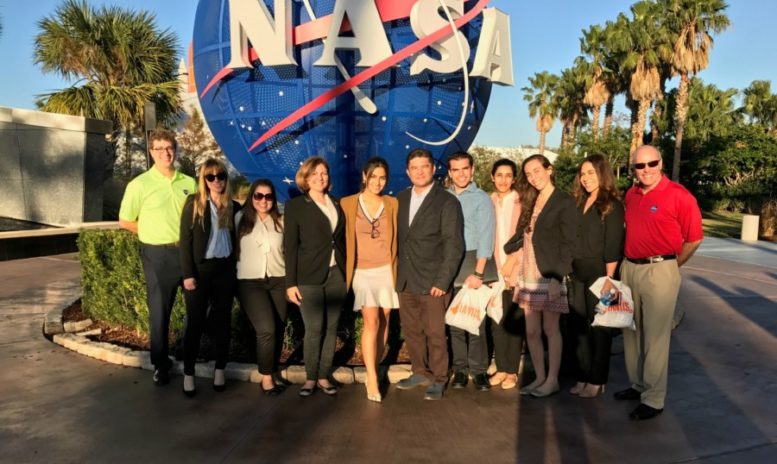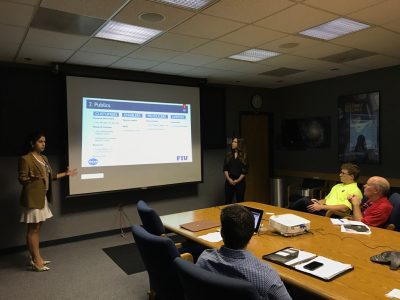
Whether it’s the tires on our cars and trucks, the fancy cordless vacuum cleaners in our homes or the cameras on our smartphones, technology developed by NASA is part of our everyday lives.
Taking the technologies created by the agency from their mission environments down to Earth is a complex endeavor. Thanks to one FIU professor and NASA’s willingness to facilitate learning experiences for universities, one class of FIU graduate students got a first-hand look at that process and an opportunity to put what they learned in the classroom into practice.
During the Fall 2016 semester, 20 students in the Global Strategic Communications program created a strategic communications plan for three different technologies developed by NASA and now slated for public use, also known as “spinoffs.”
The students created the plans as their final project for a global reputation management course taught by School of Communication + Journalism professor Elif Ozkaya, who reached out to representatives from NASA’s Technology Transfer (T2) Program to gauge interest in a potential partnership.
After seeing students from several California universities work closely with NASA on real life cases last summer, Ozkaya wanted to replicate the experience for her own students.
“I was inspired to reach out to the program to provide the same benefits for our students at FIU and I am very glad we received a positive response,” Ozkaya said. “This was an exciting project for all of us.”
The students were divided into three groups, with each group tasked with creating a plan for three different spinoff technologies being developed at NASA’s Kennedy Space Center: a closed loop system for recovering ammonia from wastewater; a unique lighting system that can be used to regulate sleep cycles and improve quality of sleep; and advanced fire retardant materials.
Established in 1964, the technology transfer program is the agency’s longest continuously operated mission and works to ensure these technologies are broadly available to the public by seeking strategic partnerships and licensing agreements to develop and commercialize them.
Since it’s inception, thousands of technologies originally designed for NASA missions have been transformed for public use –creating jobs, generating revenue, saving businesses money and saving lives.

“Technology has, and will, continue to revolutionize the world we live in and technology developers, such as NASA, will continue to assist in driving this revolution,” NASA Technology Transfer Partnership Manager Michael Lester said. “Developing the ability to help technology-developing organizations better communicate about their technology to the world, and how it can be used to improve life on Earth, is a very valuable skill in today’s world.”
Each group’s plan included an analysis of NASA’s current communication strategy as well as strategies and tactics for NASA to attract potential investors and publicity for the technologies.
“It was great to see how they are fueling innovation for commercial uses here on Earth,” says Emily Devine, one of the students in Ozkaya’s class. “This project emphasized how different industries, like tech transfer, have completely different needs, goals and established communication channels.”
Some of the suggestions ranged from website redesign and improved social media and multimedia techniques to trade shows on university campuses and widespread marketing of NASA’s annual Spinoff publication, which highlights the many places NASA shows up in daily life and showcases the technologies developed for public use.
The culmination of this project was a one-day trip from Miami to Cape Canaveral in early December for students to present their plans, findings and suggestions in person to Lester and Jonathan J. Leahy, a technology transfer specialist at NASA.
“It was a fascinating experience, and for an afternoon it allowed me to dream,” says Maxime Komornik, who worked on the fire retardant materials plan. “Our ideas and words were taken seriously, giving us even more fuel to continue working hard so one day we can be on the other side and representing an organization as respectable as NASA.”
Ozkaya and representatives from NASA’s tech transfer program hope to continue collaborating and perhaps expand the partnership into other disciplines and programs. In November, FIU signed a contract with NASA to be part of their NASA Technology Transfer University (T2U) program.
StartUP FIU has also been involved in some of these discussions, potentially to act as an incubator and help develop proof of concept stage for NASA technologies in the future.





